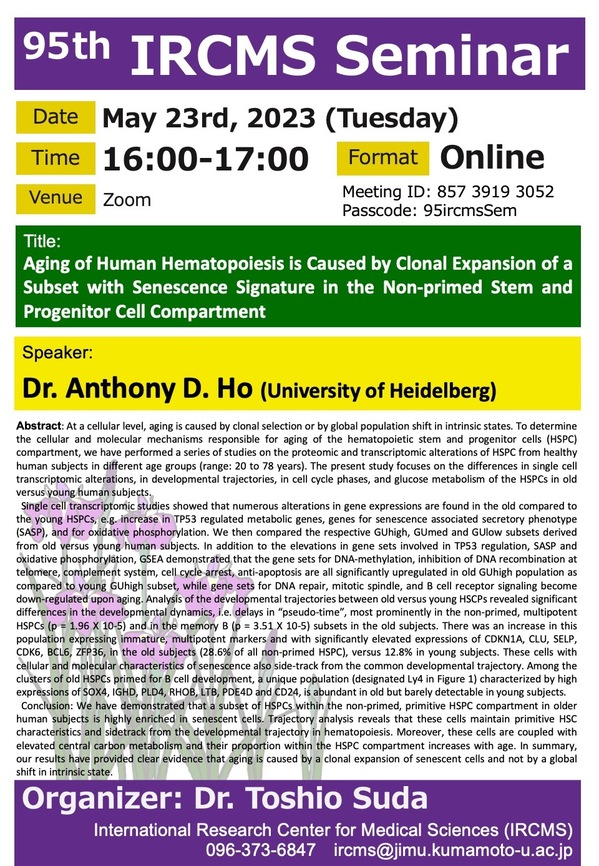- HOME
- News & Events
- [May. 23] 95th IRCMS Seminar
News & Events
[May. 23] 95th IRCMS Seminar
May 2 2023
We would like to inform you that the 95th IRCMS seminar has been scheduled as below.
* This IRCMS seminar is open to everyone.
Date : May 23rd, 2023 (Tuesday)
Time : 16:00-17:00
ZOOM : Meeting ID: 857 3919 3052
Passcode: 95ircmsSem
Speaker : Dr. Anthony D. Ho
University of Heidelberg
Title : Aging of Human Hematopoiesis is Caused by Clonal Expansion of a Subset with Senescence Signature in the Non-primed Stem and Progenitor Cell Compartment
Abstract :
At a cellular level, aging is caused by clonal selection or by global population shift in intrinsic states. To determine the cellular and molecular mechanisms responsible for aging of the hematopoietic stem and progenitor cells (HSPC) compartment, we have performed a series of studies on the proteomic and transcriptomic alterations of HSPC from healthy human subjects in different age groups (range: 20 to 78 years). The present study focuses on the differences in single cell transcriptomic alterations, in developmental trajectories, in cell cycle phases, and glucose metabolism of the HSPCs in old versus young human subjects.
Single cell transcriptomic studies showed that numerous alterations in gene expressions are found in the old compared to the young HSPCs, e.g. increase in TP53 regulated metabolic genes, genes for senescence associated secretory phenotype (SASP), and for oxidative phosphorylation. We then compared the respective GUhigh, GUmed and GUlow subsets derived from old versus young human subjects. In addition to the elevations in gene sets involved in TP53 regulation, SASP and oxidative phosphorylation, GSEA demonstrated that the gene sets for DNA-methylation, inhibition of DNA recombination at telomere, complement system, cell cycle arrest, anti-apoptosis are all significantly upregulated in old GUhigh population as compared to young GUhigh subset, while gene sets for DNA repair, mitotic spindle, and B cell receptor signaling become down-regulated upon aging. Analysis of the developmental trajectories between old versus young HSCPs revealed significant differences in the developmental dynamics, i.e. delays in "pseudo-time", most prominently in the non-primed, multipotent HSPCs (p = 1.96 X 10-5) and in the memory B (p = 3.51 X 10-5) subsets in the old subjects. There was an increase in this population expressing immature, multipotent markers and with significantly elevated expressions of CDKN1A, CLU, SELP, CDK6, BCL6, ZFP36, in the old subjects (28.6% of all non-primed HSPC), versus 12.8% in young subjects. These cells with cellular and molecular characteristics of senescence also side-track from the common developmental trajectory. Among the clusters of old HSPCs primed for B cell development, a unique population (designated Ly4 in Figure 1) characterized by high expressions of SOX4, IGHD, PLD4, RHOB, LTB, PDE4D and CD24, is abundant in old but barely detectable in young subjects.
Conclusion: We have demonstrated that a subset of HSPCs within the non-primed, primitive HSPC compartment in older human subjects is highly enriched in senescent cells. Trajectory analysis reveals that these cells maintain primitive HSC characteristics and sidetrack from the developmental trajectory in hematopoiesis. Moreover, these cells are coupled with elevated central carbon metabolism and their proportion within the HSPC compartment increases with age. In summary, our results have provided clear evidence that aging is caused by a clonal expansion of senescent cells and not by a global shift in intrinsic state.

